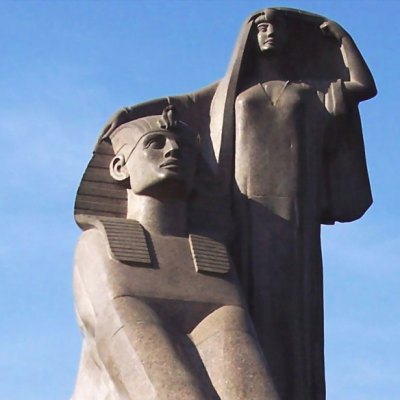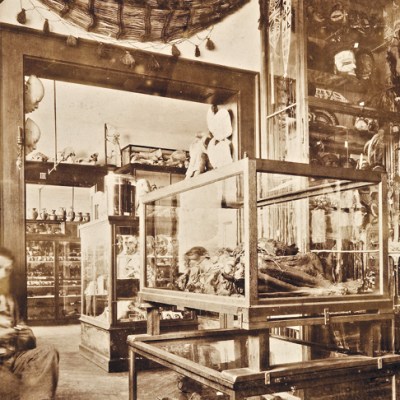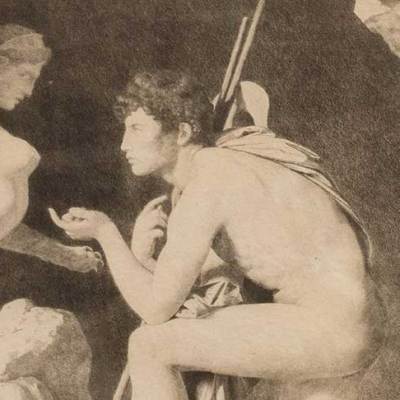In 1972 the British Museum’s display of 50 objects from the tomb of King Tutankhamun attracted 1.6 million visitors, and became the paradigm for the blockbuster exhibition as an unmissable, once-in-a-lifetime event. The last element has been devalued over the years; anyone who missed the British Museum exhibition in 1972 has until May to see 150 objects from the tomb at the Saatchi Gallery in London. This is the only British stop in what has been billed as Tutankhamun’s final tour before he returns to Cairo for good – although the Tutankhamun exhibition that came to the Millennium Dome in 2007 made the same claim. The dazzle of the visiting ‘golden treasures of the Boy King’ can, however, obscure a far longer history of displaying and admiring Egyptian objects in the UK, and distract attention from the many artefacts that can be found in the permanent collections of UK museums.
Over the past 250 years, something like a quarter of a million ancient Egyptian objects – from large to small, and beautiful to rather less beautiful – have made their way into British collections. They are the most visible dividend of a long history of trade, war, colonisation, and tourism that continues to the present day; the UK is still the largest overseas investor in Egypt and a major exporter of holidaymakers to the beaches of the Red Sea.
The largest Egyptian collections cluster in the national and university museums – the British Museum and National Museums in Liverpool and Edinburgh; Oxford, Cambridge, University College London, Swansea, Manchester, Durham – but local-authority museums also house an impressive Egyptian haul, their holdings reflecting local interests. In Bolton, Greater Manchester, textile magnates reinvested their profits from Egyptian cotton in sponsoring excavations and forming an internationally significant collection of ancient textiles. British museums rarely acquire Egyptian objects now – too expensive, no longer so relevant, too many issues with provenance – so their collections are essentially complete, flotsam from the shipwreck of British imperial power. New research into long established collections can, however, provide different perspectives on familiar objects, and sometimes even justify a new acquisition.
Lion-headed fragment (left), fragment of a bowl (middle), reunited bowl (right) (c. 1400 BC), Egypt. Bolton Library and Museum Service. Photos: DMC Photographic; © Bolton Library and Museum Service

Few things satisfy an Egyptologist more than a rummage in a museum basement, and I was able to indulge my penchant for rooting through storerooms while I was Keeper of Egyptology at Bolton 15 years ago. I was soon bewitched by one object in particular. Barely 5cm long, it was a curved fragment of glazed steatite, a typically Egyptian technique where the soft rock steatite (soapstone) is carved, dipped in a silica-based glaze, and fired. The stone hardens in firing, making the finished piece suitable for use, and the glaze becomes a translucent deep blue-green. The fragment came from the rim of a bowl about 12cm in diameter, and contained the right-hand half of a vividly carved lion’s head, a sort of knob, which had been split in two by a fault in the stone. The quality of the work – abbreviated but assured – and the clarity, depth and vivid peacock’s-feather colour of the glaze were a hallmark of the finest workshops of the first half of the Egyptian 18th Dynasty (c. 1550–1350 BC), a period that ended a little before the reign of Tutankhamun. The fragment was the sort of object that enchants in the hand but dies on display, however, and it remained in storage throughout my time at Bolton and even after the refurbishment of the museum’s Egyptian galleries in 2018. If one fragment had survived to the present day, other fragments might have too, so I added it (without much hope) to my mental inventory of missing pieces worth keeping an eye out for.
In spring last year, I was looking through pictures of a group of objects from a private collection in Germany that were to be sold at auction at Bonhams in London. Among them was a fragmentary glazed steatite bowl, about 12cm in diameter, with a broken left-hand side of a lion’s head. Surely the two pieces were related? Ian Trumble, the present curator at Bolton, brought his fragment to London to check against the Bonhams piece. They joined precisely, with only a small part of the rim still missing. The bowl had been put together from fragments by a previous owner, with other missing areas filled in with plaster, carefully painted in watercolour to blend in with the original. It became an urgent matter to get the Bonhams fragment to Bolton for good. Its owners were sympathetic to the idea of reuniting the two pieces, albeit not to the extent of donating their fragment. In the end, however, all worked out: the fragment was purchased by a group of private donors, with Bonhams generously waiving its usual commissions on the sale. The dish was given in memory of Boltonian Egyptologist Anthony Donohue (1944–2016). In the 1950s, as a teenager with an antiquarian bent, Anthony helped redisplay and catalogue Bolton’s Egyptian collections, mothballed since the Second World War. His dedication undoubtedly revived interest in Egypt in Bolton, and ensured that the museum still has a dedicated curator for its Egyptian collections – the only British local-authority museum to do so. Restored by Pierrette Squires, the museum’s conservator, the fragment from the stores has finally found its missing half and the bowl gained its rightful place on display in November.
The Reverend William MacGregor (1848–1937), Vicar of Tamworth and founder of Tamworth Castle Museum, photographed in 1886. Courtesy Tamworth Co-operative Society
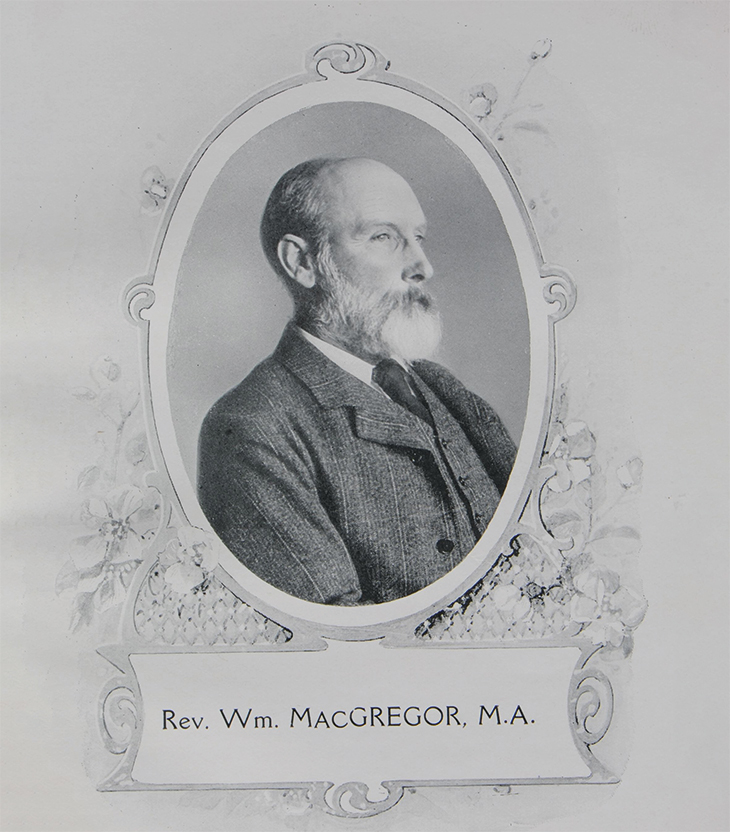
Subsequent research into the provenance of the fragments reveals that they had not been sundered for millennia, but a mere 97 years. The Bolton fragment was given to the museum by Tamworth Castle Museum in 1989 as the museum divested itself of collections it felt were no longer relevant. It had previously been part of the enormous Egyptian collection of the Revd William MacGregor (1848–1937), the wealthy Vicar of Tamworth from 1878–87, long-term incumbent of Bolehall Manor and founder of Tamworth Co-operative Society and Tamworth Castle Museum.
MacGregor did not give the bowl to the museum, but sold his whole collection to the London art dealers Spink and Son in late 1921. Spink then ‘flipped’ it in a public sale at Sotheby’s that took place over nine days in the summer of 1922. The catalogue crammed MacGregor’s 9,000-odd objects into 1,800 lots, and many pieces received minimal description. Lot 135 contained three objects, one of which, ‘a Lion’s Head from the lip of a blue-glazed schist [steatite] vessel’, fits with the Bolton fragment. The lot was sold to Spink, which was essentially bidding up its own objects at the sale, for seven guineas (worth around £400 today). The Bonhams fragment conveniently had a label saying ‘MacGregor collection’, and was probably part of auction lot 162, a group of glazed steatite objects including a dish ‘of circular form with ring foot and lion-head handle, 4 5/8 in. diam’. The repaired vessel must have broken along one of its old repairs at some point before the collection was catalogued, and the fragments ended up being sold in separate lots – an easy error to make in the rushed auction. This fragment was also bought by Spink for £2 5s. – (about £130 today). Both fragments were brought back to Spink’s for resale, but ended up in the hands of different buyers. It has taken nearly a century to remedy this negligence.
How and why did MacGregor acquire the dish, and how was something that had been so carefully restored casually broken, ignored at the auction, and then sold as two separate fragments? The answer is that by 1922 MacGregor’s tastes were out of sync with those of younger collectors. The dish was one of a number of his objects that was falling out of fashion, while other pieces he had acquired were rising stratospherically in esteem and value.
MacGregor was one of many Egyptophiles in the 19th century who travelled to the country for one reason or another and became interested in its antiquities. The opening of the Suez Canal in 1869 and Thomas Cook’s first Nile tour the same year helped Egypt open up to foreign investment and tourism; after 1882, when the British army was called in by the Khedive to suppress a nationalist revolt (and then stayed until 1956), Egypt housed a large colony of British soldiers, civil servants, professionals and tourists. In MacGregor’s case, poor health forced him to Egypt to take a rest cure in the dry Egyptian air in the early 1880s, and he began to collect Egyptian objects in earnest thereafter. There was a legal, regulated market in Egyptian antiquities in Egypt from 1835 until 1983, and dealers offered objects for sale at sites and in hotels such as Shepheard’s in Cairo. Foreign excavators could expect a share of their finds, and MacGregor subscribed generously, if not altruistically, to British digs in Egypt and Sudan.
The Egyptian Antiques Seller (1884), Charles Wilda. Courtesy Sotheby’s

Mid Victorian collectors acquired Egyptian objects avidly but with little discrimination, and a rising market encouraged dealers to cut corners to supply their clients. Dealers planted coffins in empty tombs and organised staged excavations for their important customers, such as the Prince of Wales in 1862. Clients further down the scale had to content themselves with a mummified foot or a hand, enough to conjure up the mysterious and supernatural Egypt common in fiction such as Théophile Gautier’s Le Pied de momie (1840), in which a mummy’s foot bought by a collector as a paperweight brings its ghostly owner, a beautiful princess, hopping in pursuit. Forgers also stepped in to satisfy demand. The engaging genre portrait of The Egyptian Antiques Seller (1884) by the Austrian artist Charles Wilda, who travelled in Egypt in the 1880s, shows the vendor proffering a rather dubious green statuette. Was it a poor rendering of an ancient object on Wilda’s part, or a faithful copy of a fake?
Although Egyptian objects were regarded as exotic, fascinating, and even historically important (as witnesses to the truth of the Bible or adjuncts to classical texts), they were not considered to be beautiful. A generation earlier, the trustees of the British Museum had welcomed the gift of a colossal bust of Ramesses II with a marked lack of appreciation; despite it being ‘a chef d’oeuvre of Egyptian sculpture: yet we have not placed that statue among the works of Fine Art’. More serious collectors concentrated on forming typological sequences of objects such as scarabs, amulets, and funerary ushabti figures, ticking off variants of names, materials, and headdresses as though they were collecting stamps or butterflies. Quantity not quality was the byword here.
Illustration of Egyptian faience bowls by Henry Wallis, published in ‘Egyptian Ceramic Art: The MacGregor Collection’ (1898). Brooklyn Museum Libraries – Wilbour Library of Egyptology, New York
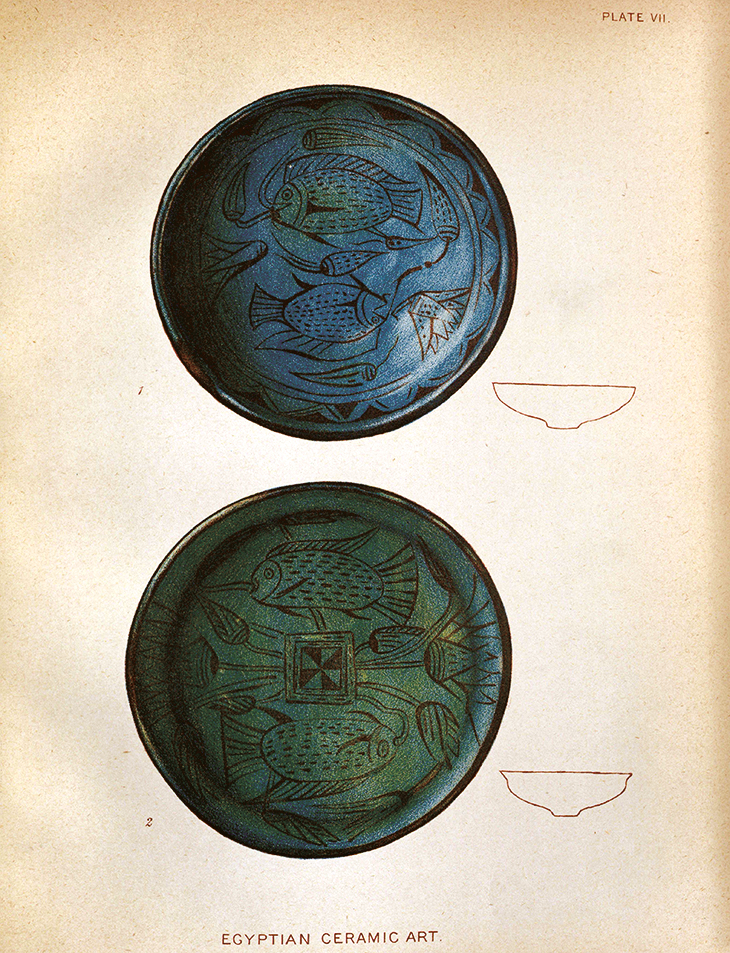
By the 1890s, however, Egyptian objects were beginning to be prized for their perceived artistic qualities. One figure behind this change (and a friend of MacGregor’s), was the Pre-Raphaelite artist Henry Wallis (1830–1916), best remembered today for his painting Death of Chatterton (1856), but at the time an important art ‘influencer’. Wallis’s modus operandi was simple – travel, acquire, promote, and sell on – and from the 1880s onwards he wrote and illustrated a series of lavish publications on early ceramics such as Italian maiolica, Greek vases, and ‘Persian’ and ‘Damascus’ (now called Ottoman Iznik) wares. Collectors could now purchase objects from Wallis and other dealers and reassure themselves that their objects were part of a published, established canon of taste: scholarship, fashion, and investment all in agreement. Egyptian ceramics were next up for promotion. In 1895, Wallis served alongside MacGregor on the organising committee of an exhibition of Egyptian objects at the Burlington Fine Arts Club in London, where he also put his own collection on loan. By 1898 Wallis had sold MacGregor most of these pieces, publishing many in Egyptian Ceramic Art: The MacGregor Collection. The Bolton bowl is not identifiable among these, but may well have been one of the objects sold by Wallis to MacGregor. It is tempting to attribute the careful trompe l’oeil painting of the fragment’s plaster restoration to an artist of Wallis’s calibre.
In the summer of 1921 there was another Egyptian exhibition at the Burlington Fine Arts Club, where the star of the show was MacGregor’s head of a king of the Egyptian Middle Kingdom (c. 1860 BC). No larger than the Bolton bowl, this chunk of dense black volcanic glass was hailed by one reviewer as ‘the finest expression of Egyptian statuary art in the world’. The exhibition attracted under 5,000 visitors, rather than the 1.6 million who would see Tutankhamun in London in 1972, but they were the people who counted in the art world. Egyptian statuary, which earlier scholars had viewed as uglier than, or not as accomplished as classical sculpture, now began to be valued more positively. Egyptian objects were in tune with the modernist aesthetic, with its preference for repetitive patterns, strong colours, plain surfaces, intriguing materials, and that great indefinable Bloomsbury quality: ‘significant form’. Pieces like MacGregor’s obsidian head possessed these qualities in abundance, and a new generation of collectors and dealers fought over his sculptures. The British Museum’s dismissive opinion of Egyptian art had been overturned.
Lord Carnarvon and his adviser Howard Carter bought lavishly at the MacGregor sale, stocking up to console themselves ahead of what Carnarvon anticipated would be his last fruitless season of excavations in the Valley of the Kings. They were outbid on the obsidian head, which sold for £10,000 (well over half a million pounds today), the highest price then ever paid for an Egyptian antiquity. MacGregor had acquired it a decade before for £100. It went instead to the oil magnate Calouste Gulbenkian, bidding against the Baltimore collector Henry Walters. Gulbenkian ensured that his name would not be linked with the purchase by entrusting his bid to an Armenian carpet-dealer who used a false name, and instructed his son-in-law to employ an elaborate system of handkerchief signals to direct the bidding. This secrecy showed that, like Old Master paintings, Egyptian art was now worth competing over.
Head of King Senusret III (c. 1860 BC), Egypt. Photo: Catarina Gomes Ferreira; © Calouste Gulbenkian Museum
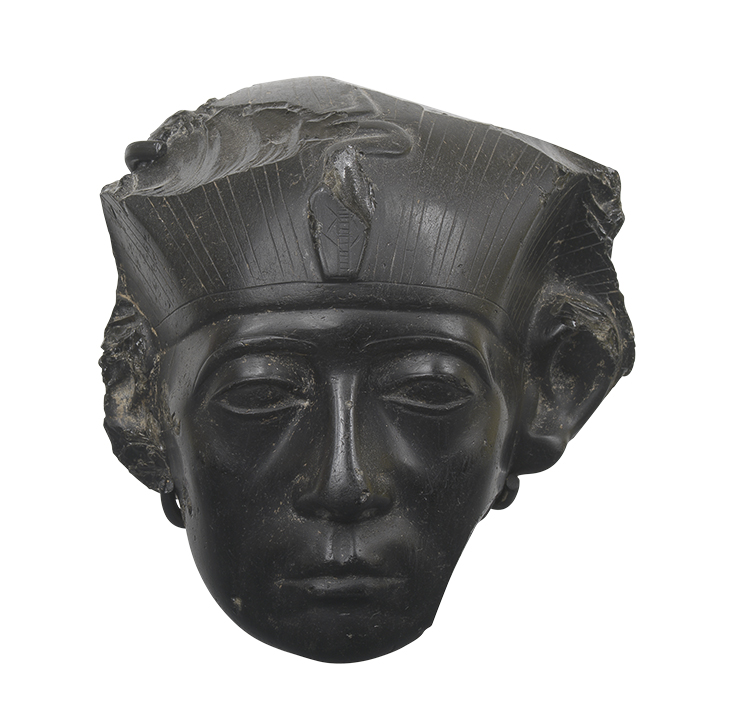
Everyone now knows that Carnarvon’s pessimism about his upcoming excavations was unfounded. The discovery of the tomb of Tutankhamun in November 1922 revealed unimaginable treasures, half of which Carnarvon expected to be given by the Egyptian government in accordance with his excavation contract. Carnarvon’s death in 1923, and Egypt’s growing independence from British control, scuppered these plans: Tutankhamun’s burial goods – minus a few pieces discreetly abstracted by Carter – remained in Cairo.
The discovery of Tutankhamun’s tomb is usually regarded as the beginning of ‘Egyptomania’ in the West, where Egyptian motifs were applied to cinemas, factories and even condoms. From another perspective, however, it’s clear that by 1922 Egypt was already trendy with taste-making collectors, dealers and writers, who gave Carter and Carnarvon’s discovery the intellectual and social backing that turned a passing news item into a permanent source of interest. Ancient Egyptian objects were no longer spooky, but beautiful, topical, and perhaps a valuable investment, too. Contrary to popular opinion, Tutankhamun did not create Egyptomania, but capitalised on an existing trend.
It is too much to hope that the centenary of Carnavon and Carter’s find in 2022 will see museums and the media call time on the clichés. Like Gautier’s mummy’s foot, they’ve taken on a life of their own. Perhaps the centenary of the MacGregor sale at the same time can encourage us to think about the ways in which other Egyptian objects came to the UK. The little dish in Bolton doesn’t just tell us about craftsmanship in 18th Dynasty Egypt; its breakage and the separation and recent reunion of its two halves also provide valuable insights into the taste, scholarship, and politics of the last 120 years. If museums can no longer acquire Egyptian objects at the same pace as the 1920s, why don’t they re-examine their own histories as well as their storerooms?
From the January 2020 issue of Apollo. Preview and subscribe here.
